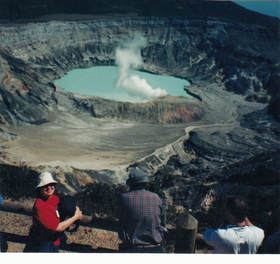 Sherrill, Poas Volcano, Costa Rica
Sherrill, Poas Volcano, Costa Rica "Which volcano?"
"Any volcano—the big one."
Since Costa Rica was crowded with volcanoes, around 100 of them, at least seven active in 2001, there was a chance that she'd get her wish.
Sherrill had always been fascinated by volcanoes. Years before, on one of our trips to visit her mother in Hawaii, we'd stayed at the lodge on top of Kilauea, next to the huge caldera and had watched grenades of steam shoot from the red-rimmed, half-hardened lava as it cracked, bubbled, and shook, but no eruption broke through the shell around the crater.
"I'm never here at the right time," she'd mourned.
Several days before gazing into the volcano, we flew into San Jose, the country's capitol and largest city. Trapped in a valley encircled by volcanic mountains, the city presented a colorful, sometimes bizarre, jumble of old and new: from colonial-era homes to faceless office buildings and high-rise hotels, from eighteenth century neoclassic buildings to recently constructed factories and shops, from quite nice public parks to gaudy neon lights and intrusive billboards.
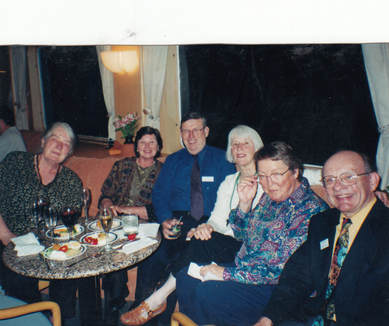 Six friends ready for adventures
Six friends ready for adventures 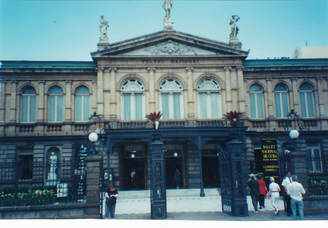 Teatro Nacional, San Jose, Costa Rica
Teatro Nacional, San Jose, Costa Rica A trip to a mountainside coffee plantation and mill gave us an idea of how those coffee barons ade their fortunes. We followed the process from the planting of the seedlings to growing the coffee plants, then harvesting, sorting, peeling, fermenting, and drying the "coffee cherries" to produce the beans. It didn't take long before we felt high just from the rich coffee aromas—and, of course, our hosts were hoping we'd buy and take home quantities of their product.
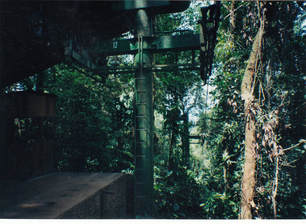 Aerial tram, Braulio Carrillo National Park, Costa Rica
Aerial tram, Braulio Carrillo National Park, Costa Rica "Those are houseplants!" Sherrill exclaimed, pointing to giant philodendrons with leaves as big as a small car. "Don't they know that?"
Monster elephant ears and gigantic ferns growing below and around us dwarfed the ones that she grew in our Berkeley garden and the lush quantities of orchids and bromeliads put to shame her own formidable collection. Moss and lichen coated tree trunks and branches with a scabrous greenish skin and the shameless blossoms of unfamiliar flowers played hide-and-seek through the shadowy green foliage. Above our heads, low clouds flirted with the whispering tree tops. Mist briefly turned into a drizzle, but we soon left it behind.
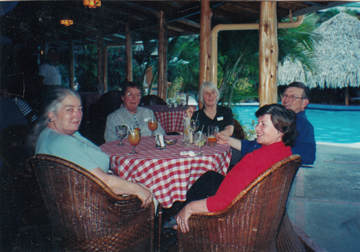 Another day in paradise: Sherrill & friends
Another day in paradise: Sherrill & friends "Don't worry," she told me. "You don't need to stay with me. I know you'd be bored."
She was right. I didn't have the patience to stare through binoculars into trembling leaves, trying to focus on a bit of color that might turn out to be certain type of woodpecker or hawk, so instead I hiked along jungle trails and actually glimpsed an armadillo, a white-faced capuchin monkey, and a raccoon. The fact that I had been annoyed many times by raccoons in my own backyard didn't spoil the fun of catching sight of one in the wild. At least, this one wasn't going to tip over my garbage can. Meanwhile, Sherrill added several exotic birds to her ever-growing list, but when she told me their names I was no wiser than before.
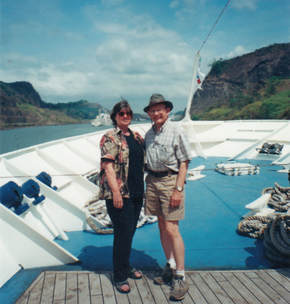 Sherrill & Bruce on Yorktown Clipper
Sherrill & Bruce on Yorktown Clipper "Marenco has been so well protected," the ship's naturalist told us, "that it's home to many species that are rare or have totally vanished anywhere else in Central America. It was a battle, but the scientists and conservationists managed to defeat the lumbermen who wanted to destroy our rainforest. And don't forget that it's visitors like you who help pay for these parks and preserves."
A very effective sales pitch, we agreed.
What, I wondered, would it be like to cruise around in a boat like that? Then I noticed a woman in an expensive-looking beach outfit a few yards away, also looking out to sea.
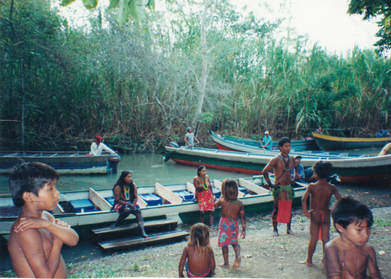 Choco indigenous people, Darien jungle, Panama
Choco indigenous people, Darien jungle, Panama "I'm on it," she replied. "A passenger." She stepped closer. "Believe me, you don't want to be on it. You never met such boring people." I must've looked surprised, because she added, "They don't give a damn about any of this." She gestured broadly at the beach and the rainforest behind us. "Too busy trying to impress each other with how important they are. They came on the cruise just because it was expensive." She turned sharply toward me. "Are you on that little boat I saw earlier?" I admitted that I was. "I'd rather be on that. I'm sure you're seeing more than we are. And are with nicer people." Then she started to walk away, but glanced back briefly. "I don't want to miss cocktail hour—the highlight of our day."
The next day, when we were at sea on the way to Panama, gave us an opportunity to hear lectures from the guest speakers on board, including a very informative one about Panama's Darien Jungle, where we'd soon arrive, and to enjoy the sea breezes on deck while looking out for seabirds and whales—maybe even a school of dolphins, if we were lucky. Who needed all those fancy sails?
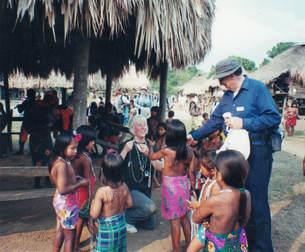 Cathy & Larry, Choco Village, Panama
Cathy & Larry, Choco Village, Panama 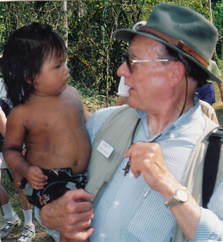 Sizing each other up: Bruce & Choco boy
Sizing each other up: Bruce & Choco boy 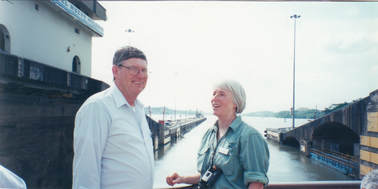 Larry & Cathy, Panama Canal
Larry & Cathy, Panama Canal To be continued....
Please pass the posts on to anybody else you think might enjoy them.
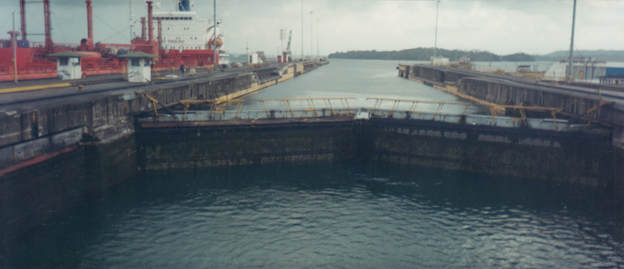
 RSS Feed
RSS Feed